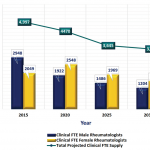The study group estimates that 50% of adult rheumatologists and 32% of pediatric rheumatologists practicing now will retire in the next 10 years, he said.
Soaring Gaps
Patient demand, or U.S. adults with doctor-diagnosed arthritis, is projected to rise from 52.5 million in 2012 to 67 million by 2030, according to the study. Demand is based on projections of increased rheumatic disease diagnoses by 2030 and an estimate that 25% of a rheumatologist’s patients will have OA.
With the soaring patient demand, current and projected figures indicate the rheumatology workforce will be insufficient to meet that demand, Dr. Battafarano said. Here are some of the study’s crucial findings:
- Estimated 2015 adult rheumatology workforce: 5,595 (adjusted to 4,497 clinical FTE)
- Projected 2030 adult rheumatology workforce: 4,246 rheumatologists (adjusted to 3,455 clinical FTE)
- Projected physician need to meet adult patient demand in 2030: 8,184
- Estimated 2015 pediatric rheumatology workforce: 300 (adjusted to 287 clinical FTE)
- Projected 2030 pediatric rheumatology workforce: 251 total providers (adjusted to 231 clinical FTE)
- Projected physician need to meet pediatric patient demand in 2030: 461
The 2005 ACR study recommended that the subspecialty should increase adult and pediatric fellow positions, facilitate a Web-based curriculum for NPs and PAs, analyze practice efficiency and promote advocacy for a value-based rheumatology care and compensation model, said Dr. Battafarano. Rheumatology fellows’ slots were increased overall and, today, about 90% of the adult positions and 50% of the pediatric positions are filled.
Dr. Battafarano said the question arises, “Can’t we just solve this problem with graduate medical education?” He said, “There are 107 adult fellow FTEs coming into our workforce every year, but that cannot compensate for the approximate 220 adult retirements per year. So GME training alone is not the answer.” He added that only half of pediatric rheumatology fellowship slots in 36 programs are currently filled.
According to the study’s findings, in 2015, there were an estimated 248 active NPs working in adult rheumatology, or 228 clinical FTEs, and an estimated 22 NPs working in pediatric rheumatology, or 20 clinical FTEs. The NP rheumatology workforce is expected to increase to 313 adult clinical and 24 pediatric FTEs by 2025. The 2015 study also revealed that 207 clinical FTE PAs are working in adult rheumatology and four clinical FTE PAs are working in pediatric rheumatology now, and by 2025, there will be 263 adult and five pediatric PAs.
“Although the NP and PA rheumatology provider data may be limited, the projected NP and PA increases will not significantly compensate for the overall workforce shortages over the next 10 years,” said Dr. Battafarano.
Demographics & Geography
A dramatic shift in the demographics of rheumatologists will occur over the next 15 years. Men made up 60% of the 2015 adult rheumatology workforce, but by 2030, 60% will be women, Dr. Battafarano said. Currently, 68% of pediatric rheumatologists are women. Rheumatology currently lacks ethnic diversity: 80% of the study’s survey respondents identified as non-Hispanic and 75% as white.


